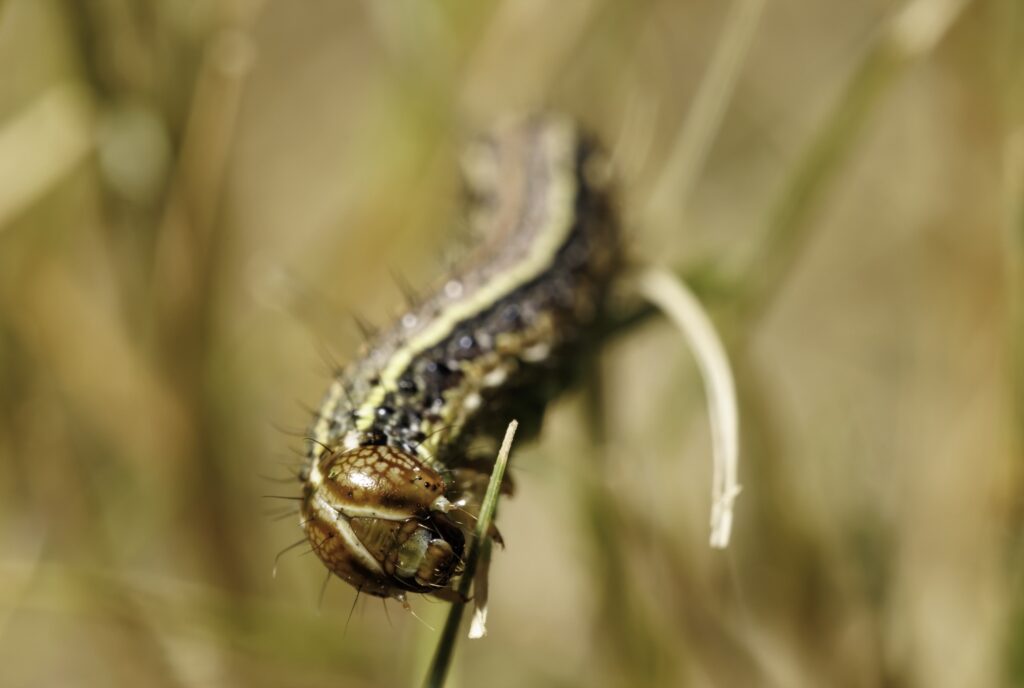By Dean Ruhl
STILLWATER, Okla. – Kylie Johnson’s lawn is moving.
Not literally. But at a glance, each blade of grass appears to be shaking, not because of the wind, but instead because of a fall armyworm infestation on her land. Along with her husband, Aaron, Kylie runs Lone Rock Longhorns, a cattle business on roughly 2,500 acres in Payne County. Recently, the family has dealt with a heavy armyworm infestation heading into the fall months, causing some concern.

“I’d say it’s defeating because now we’re feeding hay like it’s snowing outside,” Kylie Johnson said.
The Johnson family isn’t alone. Fall armyworm activity has increased across the state of Oklahoma, with the potential to cause major economic damage.
The fall armyworm – earning its name for the way it “marches” from food source to food source – population fluctuates every year. Cooler and wetter weather patterns early in the year factor into what activity will look like in the fall, explains Ashleigh Faris, Oklahoma State University Extension’s cropping systems entomologist.
“The rainfall we have had in Oklahoma has allowed for a lot of lush, green vegetation,” Faris said. “Which is excellent and attractive habitats for the female moths to lay their eggs and fall armyworm larvae to feed.”
The fall armyworms attack more than 350 plant species from 76 plant families. Paired with its ability for far migrations and plentiful reproduction, there is potential for serious economic damage.
Increased activity, combined with planting times for winter wheat, makes for a “perfect storm” for producers this year, Faris said.
“These insects can cause stand loss, especially in the seedling stages,” Faris said. “In severe cases of stand loss, producers may need to replant their winter wheat.”
To avoid a large-scale outbreak, catching the infestation early is vital. Growers should implement scouting into their daily routines, checking fields and edges around for larvae or signs of frass, a yellow/brown mush left by the larvae on leaves.
Fully developed fall armyworms measure 1.5 inches long. The early instars measure approximately half the size and feed on leaves by scraping on the top layer, leaving transparent areas on the leaf. This process, called “windowpaning,” is crucial for early detection.
When scouting in the morning and late evenings, look for the armyworms on the crops. During the day, examine the base of the plant and the top of the surrounding soil.
“The current economic threshold for fall armyworm in wheat is 3-4 larvae per foot of row,” Faris said. “Producers should reach out to their local county Extension office for guidance on selecting an insecticide that is labelled specifically for fall armyworm.”
The smaller the larvae, the easier to manage, Faris said. Ninety percent of damage occurs in the final two instars, and the larger larvae are less susceptible to insecticides.
The consequences of not dealing with a fall armyworm outbreak could be catastrophic. For summer crops currently being harvested, armyworm infestations can reduce yield. For winter wheat currently being planted, a complete loss could be suffered.
“When wheat stand is a complete loss and replanting is required, it can be economically devastating, Faris said. “It’s a race against the clock to plant while conditions are still conducive.”
Crops aren’t the only impacted area. The larvae can feed on turfgrasses and lawns, too, impacting homeowners and businesses.
Nathan Walker, a turfgrass integrated pest management scientist and OSU Extension specialist for turf disease and pest diagnosis, said scouting is vital to determining next steps for treating any current or future outbreak.
For homeowners, a soap flush – a process of mixing one tablespoon of lemon-scented dish soap and 1-2 gallons of water and pouring it on several small areas of a lawn – is recommended. The soap irritates any hidden larvae, pulling them to the surface.
If 3-4 larvae are found per square foot, some homeowners or commercial turf and golf course managers may decide on an insecticide treatment to prevent additional damage.
Most turfgrasses, such as bermudagrass or zoysia lawns, should recover from fall armyworm damage without needing treatment.
Severe damage from fall armyworms can result in homeowners needing to overseed their fescue grass this fall, something that is often done regularly every few years, Walker said.
If a homeowner decides to use an insecticide, Walker stressed carefully reading the label and following all safety precautions, such as wearing shoes, long pants, gloves and protective eyewear.
“We want to avoid underdosing, because it encourages resistance,” Walker said. “And overdosing, which is not necessary and expensive.”
The fall armyworm does not overwinter in Oklahoma, meaning the first killing frost later this year will eradicate the problem. In the meantime, Faris and Walker stress remaining vigilant, scouting for the fall armyworms and taking proper measures.
OSU Extension uses research-based information to help all Oklahomans solve local issues and concerns, promote leadership and manage resources wisely throughout the state’s 77 counties. Most information is available at little to no cost.










